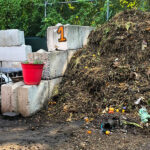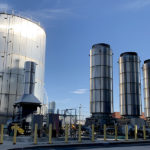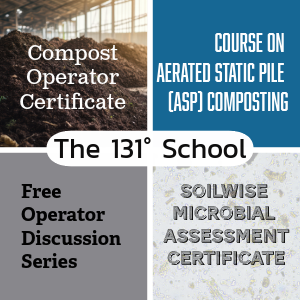Top: An aerated mass bed system is used for composting yard trimmings, and some food waste. A Vermeer elevating face turner moves material 22 feet laterally on the pad in each turning event. Photo courtesy of the City of Phoenix
Craig Coker
Fourth of a series of articles on issues to consider when planning a new composting facility in the U.S
Planning a new merchant organics recycling facility requires considerable thought and investigation. As the old adage goes, “Proper prior planning prevents poor performance.” This facility planning series is oriented to helping you think through the aspects of proper prior planning. Part I dealt with how to develop a Waste Capture Plan. Part II covered methods to assess the markets’ potential to absorb your compost and/or soils products. Part III looked at how to figure out how much room you would need for your new composting facility. This article explores how to evaluate different composting approaches or methodologies.
While deciding what composting system to use is primarily a function of economics (mostly capital costs), influencing considerations include your materials handling experience, feedstocks, size and location of available land, environmental considerations such as storm water and wastewater management, proposed size of facility, potential growth opportunities and need for scalability, your time and budget resources, state and local regulations, and processing time.
Odor And Time Considerations
The degradation potential of various feedstocks is a key factor. Degradation potential can be viewed as odor-producing potential. Some feedstocks, like yard trimmings, are only highly degradable at certain times of year, while others, like food scraps, animal manures and sewage sludges, always have a high degradation potential. Feedstocks with low degradation potential favor low technology, passive aeration, open systems, while high degradation feedstocks favor forced aeration, enclosed or in-vessel systems.
Minimizing the potential for off-site odor impacts is also an important consideration. For smaller area sites within 1,000 to 1,500 feet of a sensitive receptor (such as a home, school, park, shopping center, church or anywhere the public gathers), composting systems should have higher degrees of process and environmental control, which favors enclosed, covered, contained and controlled systems. Large rural sites distant from neighbors can use lower technology open systems. If you are thinking of working with a municipality in a public-private partnership, recognize that some municipal sites have histories of environmental issues, like a landfill, which can influence system selection. Some communities siting composting facilities with other public facilities may insist on a higher level of process and environmental control to mitigate potential additional impacts on residents weary of their public waste management neighbor.
Time can be a factor in system selection. If there is no need to get product to market quickly, e.g., if your processing fees for waste management are your major source of revenue, there may be less urgency to rush product to market for cash flow purposes. That favors less capital expense, less equipment, less management and more space, which might favor windrows over ASP or in-vessel. If a composting enterprise needs to get product to the market quickly (for product demand and/or cash flow reasons), then more capital expense, equipment and management, and sometimes less space, are usually necessary.
The availability of resources (e.g., equipment, pavement, buildings, people and money) often influences system selection. Farmers wishing to expand into composting already have resources like tractors they can put to use, as do businesses in related industries that get into composting (e.g., plant nurseries and conventional materials recyclers) and municipal governments with existing public works infrastructure. The economic advantages of sharing land, equipment and labor can be substantial (Platt, 2014).
Composting methods fall into three general categories — passively aerated systems that include static piles and turned windrows; actively aerated systems; and in-vessel. The following section discusses each method, and offers the advantages and disadvantages to each.
Passively Aerated Systems
Passively aerated static piles could be called “Nature’s original compost pile.” This composting method requires patience as it can take months, or longer, for the organics to decompose. Passive aeration is best used for slowly decomposing feedstocks like leaves, brush, bark, wood chips and residues like horse manure and bedding (Rynk, 2022). It is also the primary composting method for livestock mortalities (Figure 1).
Static piles rely on natural convection for aeration, where air heated by microbial decay rises out of the pile and is replaced by cooler air migrating inwards from the sides. Two methods of facilitating natural aeration are:
- Place perforated plastic pipes cross-wise into the pile with the ends exposed to the atmosphere, which is known as the Passively Aerated Windrow System (PAWS).
- Build the compost pile on a deep (18-inch thick) bed of coarse wood chips, which is known as the Natural Aeration Static Pile (NASP).
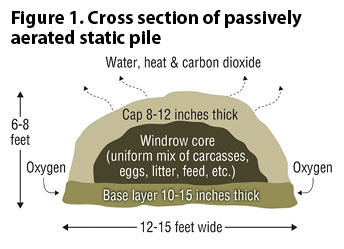 The other form of passive aeration is windrow composting — the most common composting system used in the U.S. today due to its suitability to a wide variety of materials and capacities and low capital and operating costs. Windrow composting involves forming your composting feedstocks into long, narrow, low piles known as windrows that are about twice as wide as they are high. The length can be as long as the available space. Windrows are built using front-end loaders, skid-steer loaders and excavators.
The other form of passive aeration is windrow composting — the most common composting system used in the U.S. today due to its suitability to a wide variety of materials and capacities and low capital and operating costs. Windrow composting involves forming your composting feedstocks into long, narrow, low piles known as windrows that are about twice as wide as they are high. The length can be as long as the available space. Windrows are built using front-end loaders, skid-steer loaders and excavators.
Space requirements for a windrow composting pad vary depending on method of turning, as windrows can be turned with a loader, or with a drum turning machine. These turners are either a pull-behind type towed with a loader or a tractor, or a self-propelled straddle-type machine. Turning with a loader or pull-behind turner requires 15 to 20 feet of space between each windrow, where straddle-turned windrows can be as close as 2 to 3 feet apart. If you want to use a tractor-pulled turner, make sure the tractor has an engine with at least 85 hp and that the transmission has an ultra-low speed gear, known as a “creeper gear” to allow it to drive slowly (about 20-25 feet per minute) when pulling a turner through a windrow.
Windrow composting is commonly used to process yard trimmings (grass, leaves, brush), and woody materials. Turning the windrow can help break down the particle sizes in these more heterogeneous feedstocks depending on drum design (flail-based are better than auger-based designs for particle size reduction). Food scraps, industrial residuals (i.e. food processing or paper wastes), manures, and biosolids are also composted in windrows, but these facilities are usually located in more arid, warmer regions to minimize impacts from weather and climate, and/or use fabric or compost covers to deter birds, dogs, raccoons, and rodents drawn to the more putrescible feedstocks. An added advantage of covering windrows is to deter possible complaints from neighbors, as people “smell with their eyes.”
Actively Aerated Systems
Actively aerated composting systems use fans and blowers to move air through a composting pile to maintain aerobic conditions. There are generally three types of aeration systems: positive (or forced draft), negative (or induced draft), and bi-directional. Figure 2 illustrates positive and negative aeration.
In a positive aeration system, air is introduced through perforated pipes at the base of the pile and allowed to migrate up through the pile, carrying entrapped gases and moisture up and out of the pile. In some positively aerated systems, a layer of compost or a fabric cover is used to help manage odors and retain heat and moisture in the pile.
Negatively aerated systems pull air downward through the pile and into the aeration pipes. This “exhaust” air has high temperature and moisture content, so is usually cooled prior to entering an odor control system. Cooling the air condenses the moisture, so condensate management systems are needed. It is important to have efficient condensate traps between the piles and the air extraction blowers to keep the corrosive condensate moisture out of the blower mechanisms. Odor control systems are usually either biofilters or chemical scrubbers. Bidirectional systems have more advanced ducting and controls and switch between positive and negative air flow to better control temperatures in the piles.
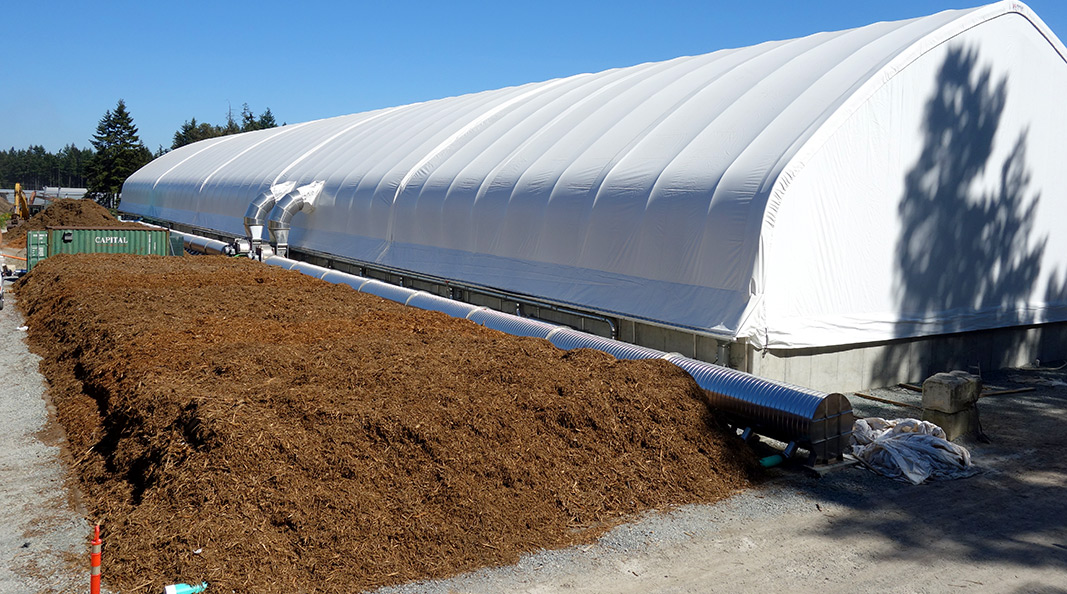
Aerated static pile composting takes place in a fabric building. Exhaust air is pulled through the adjacent biofiler. Photo courtesy of Engineered Compost Systems.
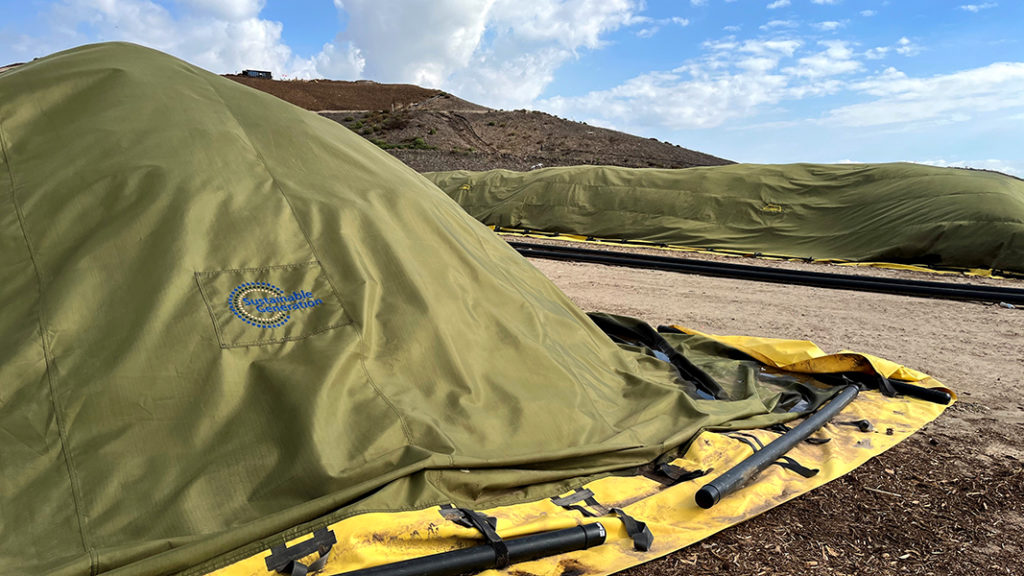
Republic Services is using Sustainable Generation’s SG Mobile® System with GORE® Covers at its Otay Landfill composting facility.
Composting systems using active aeration come in a wide variety of technology options, including simple aerated static piles (ASP) — either out in the open or covered with a pavilion-style or fabric-covered roof — to containerized systems enclosed by concrete bins, inside modified shipping containers, or covered with breathable fabric covers. Some ASP systems fall into a grey area, e.g., composting inside a modified shipping container may be considered in-vessel, as does an agitated bay system inside a building. The reality is that many in-vessel systems have some mechanism for introducing air and many ASP systems are enclosed in some sort of boundary condition (block bunkers, reinforced-concrete wall bunkers, tunnel reactors, modified shipping containers, etc.). As described in the next section, I define in-vessel as some sort of packaged electro-mechanical composting system (e.g. Rocket Composter, FOR Solutions, GMT Earth Flow, B&W Organics rotary drum, etc.), whereas I define ASP as primarily a forced aeration system enclosed in some sort of boundary conditions.

The Town of Bennington, Vermont built an IPS agitated bay facility in 1992 at its wastewater treatment plant (WWTP) to compost biosolids with yard trimmings. The 4-bay Bennington Compost Facility utilizes equipment supplied by BDP Industries.
In-Vessel Systems
In-vessel systems can be considered as “bioreactors.” A bioreactor is an enclosed, rigid structure or vessel (reactor) used to contain the material undergoing biological processing. These systems tend to have integrated control systems that monitor process parameters like temperature and oxygen (or carbon dioxide). A mixing and loading hopper/conveyor and a biofilter for exhaust odor management are often included. Material is moved through the bioreactor by various means, including moving floors, spinners, augers, and similar dry materials transport devices. The sizes of these units vary by capacity, with smaller units able to fit into one parking stall, while larger units are 12 feet by 15 feet wide and have lengths greater than 20 feet.
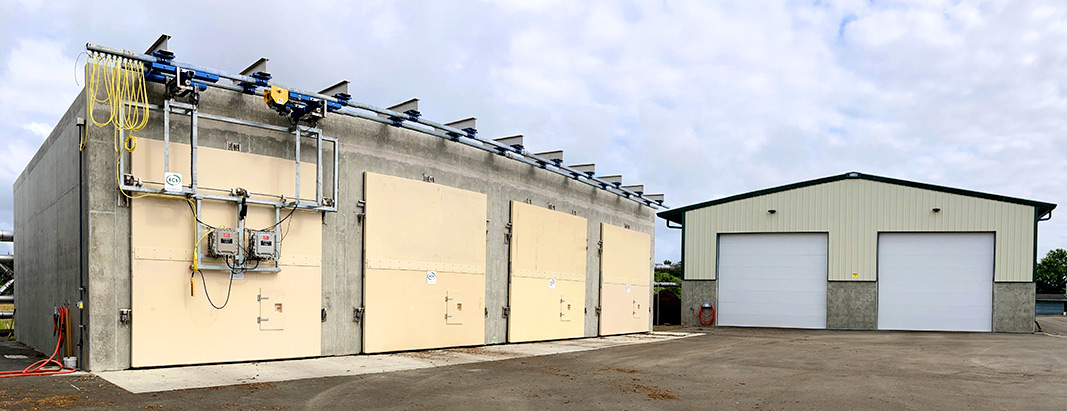
The City of Long Beach (CA) composts biosolids in aerated tunnels (above left) supplied by Engineered Compost Systems. Photo courtesy of ECS
Bioreactors can be classified by their configuration (horizontal, vertical, with channels, with cells, with containers, with tunnels and with rotating drums), by operational mode (continuous or batch), and by static or dynamic movement of material within the reactor (Diaz, 2005). Many bioreactors are dynamic systems, in that forced aeration is supplemented by internal turning or agitation, and typically operated in continuous mode, rather than in batch mode. Some vendors have smaller capacity systems and are modular, so are suitable for community, on-site, and on-farm applications. These systems are suited to capacities of less than 20,000 lbs/day of source separated organics (Environment Canada, 2012). Once capacity is reached, additional vessels will need to be procured.
Before You Buy
Composting systems, and the mobile equipment used to support them, are all available from various technology providers. If you are going to buy a system or equipment, then do your homework first. Get lists of installations and contact information from the supplier and set up interviews with references. Make up a list of questions and provide it to the interviewed references ahead of time (this signals you are respectful of their time). This approach allows you to evenly compare several references across different systems.Then go out and see a system in operation. Few activities in composting facility planning are as educational as spending time at a facility using an approach to composting similar feedstocks as those you are planning. I have found that much can be learned about how a composting system works by visiting on a cold, wet day in the winter.
Craig Coker is CEO of Coker Composting & Consulting near Roanoke, VA and is a Senior Editor at BioCycle CONNECT. He can be reached at ccoker@cokercompost.com.





